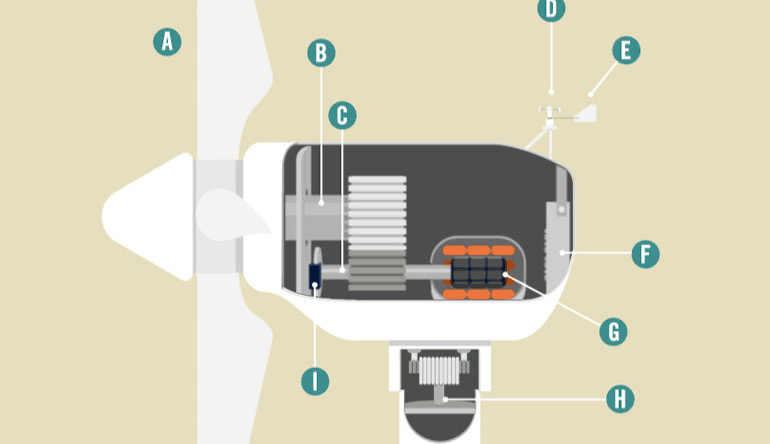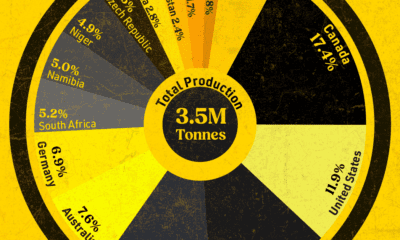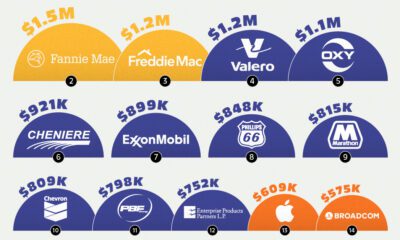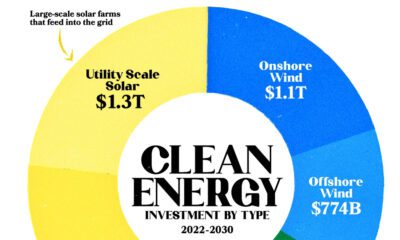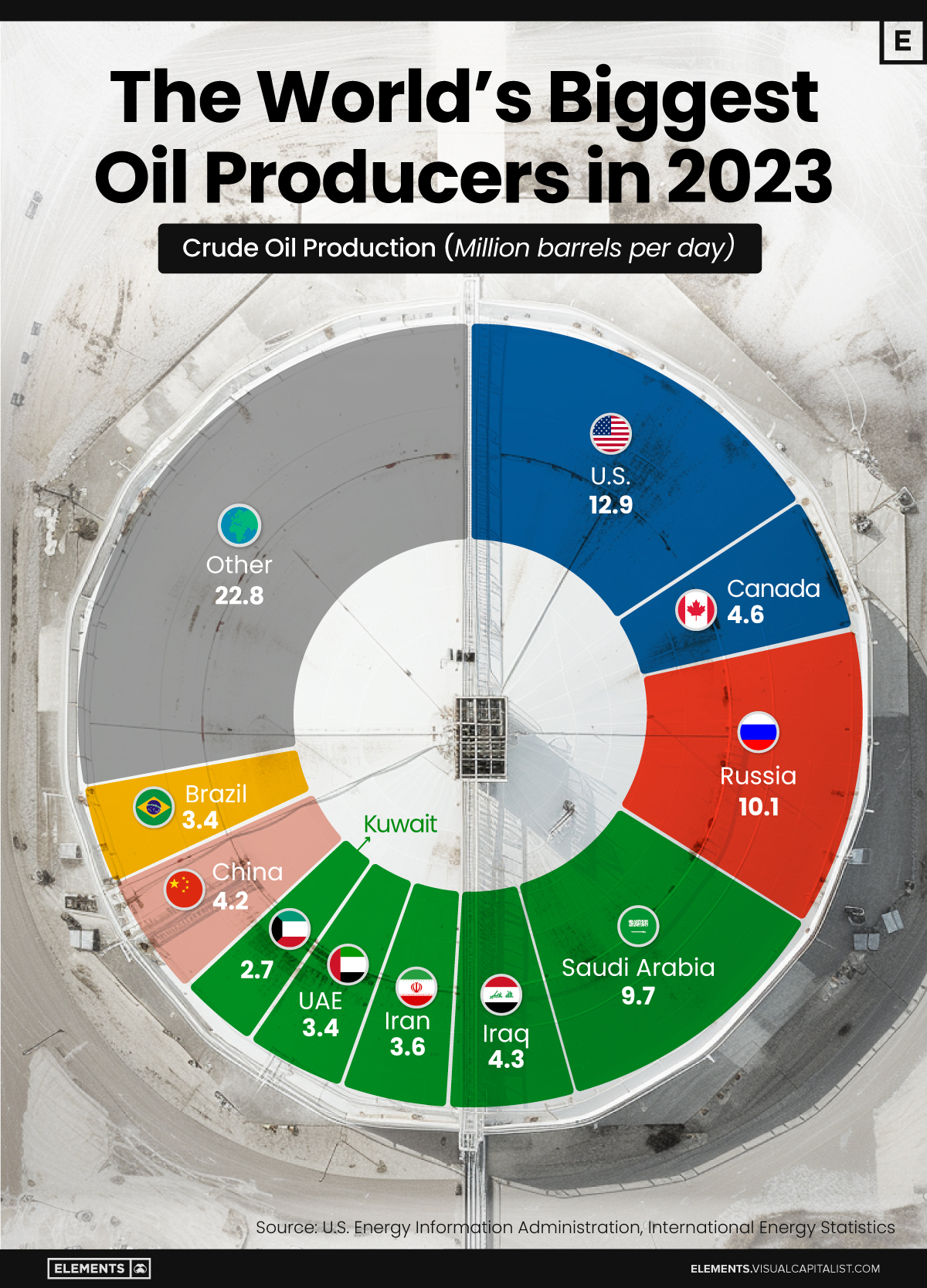Energy
Animation: How Wind Turbines Work
The windmill, which converts wind into rotational energy to mill grain or pump water, has been around since antiquity. It’s even been claimed that Ancient Babylonians planned to harness wind as early as almost 4,000 years ago, as part of a scheme for one of Hammurabi’s ambitious irrigation projects.
By the end of the 19th century, wind energy took on a whole new meaning as engineers in Scotland, Denmark, and the United States invented the first wind turbines that generated electricity. Many technological improvements have been made since, and now modern wind farms dot the landscapes of countries around the world.
Related Topic: What it Would Take to Power New York City
Today, wind power is an important element of the green energy mix, and its estimated that 432 GW of wind farms are installed globally. In the United States, nearly 5% of all power is now generated by wind.

How Wind Turbines Work
How do these massive propellers get into motion? Once they are turning, what do they do?
As shown in the animation, it’s all about the lift and drag forces created by the shape of the blades. Lift acts perpendicular to the direction of wind flow and drag acts parallel to the direction of wind flow.
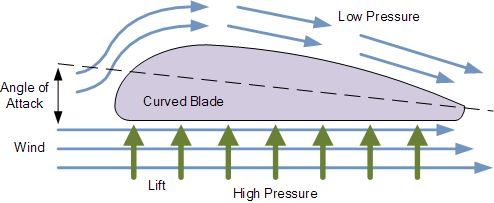
The blades are designed so that when wind passes, a low-pressure pocket of air is created by faster moving wind on the curved side of the blade. This sucks the blade in the downwind direction, creating lift. The blades are then connected to a series of shafts that spin an electromagnetic induction generator, and this creates electricity.
There are some other bells and whistles that help to maximize efficiency in a modern wind turbine as well.
The anemometer measures wind speed, while the controller starts and stops the turbines to operate only at desirable wind speeds (between 8 and 55 kmph). The wind vane measures the wind’s direction and communicates this information to the yaw drive, which helps make adjustments to the turbine’s orientation. Lastly, there is also a braking system installed which can be used for emergency stops when wind speeds get too extreme.
Original graphic by: SaveOnEnergy
Energy
The World’s Biggest Oil Producers in 2023
Just three countries accounted for 40% of global oil production last year.

The World’s Biggest Oil Producers in 2023
This was originally posted on Elements. Sign up to the free mailing list to get beautiful visualizations on natural resource megatrends in your email.
Despite efforts to decarbonize the global economy, oil still remains one of the world’s most important resources. It’s also produced by a fairly limited group of countries, which can be a source of economic and political leverage.
This graphic illustrates global crude oil production in 2023, measured in million barrels per day, sourced from the U.S. Energy Information Administration (EIA).
Three Countries Account for 40% of Global Oil Production
In 2023, the United States, Russia, and Saudi Arabia collectively contributed 32.7 million barrels per day to global oil production.
| Oil Production 2023 | Million barrels per day |
|---|---|
| 🇺🇸 U.S. | 12.9 |
| 🇷🇺 Russia | 10.1 |
| 🇸🇦 Saudi Arabia | 9.7 |
| 🇨🇦 Canada | 4.6 |
| 🇮🇶 Iraq | 4.3 |
| 🇨🇳 China | 4.2 |
| 🇮🇷 Iran | 3.6 |
| 🇧🇷 Brazil | 3.4 |
| 🇦🇪 UAE | 3.4 |
| 🇰🇼 Kuwait | 2.7 |
| 🌍 Other | 22.8 |
These three nations have consistently dominated oil production since 1971. The leading position, however, has alternated among them over the past five decades.
In contrast, the combined production of the next three largest producers—Canada, Iraq, and China—reached 13.1 million barrels per day in 2023, just surpassing the production of the United States alone.
In the near term, no country is likely to surpass the record production achieved by the U.S. in 2023, as no other producer has ever reached a daily capacity of 13.0 million barrels. Recently, Saudi Arabia’s state-owned Saudi Aramco scrapped plans to increase production capacity to 13.0 million barrels per day by 2027.
In 2024, analysts forecast that the U.S. will maintain its position as the top oil producer. In fact, according to Macquarie Group, U.S. oil production is expected to achieve a record pace of about 14 million barrels per day by the end of the year.
-

 Technology2 weeks ago
Technology2 weeks agoRanked: The Most Popular Smartphone Brands in the U.S.
-

 Automotive1 week ago
Automotive1 week agoAlmost Every EV Stock is Down After Q1 2024
-

 Money1 week ago
Money1 week agoWhere Does One U.S. Tax Dollar Go?
-

 Green2 weeks ago
Green2 weeks agoRanked: Top Countries by Total Forest Loss Since 2001
-

 Real Estate2 weeks ago
Real Estate2 weeks agoVisualizing America’s Shortage of Affordable Homes
-

 Maps2 weeks ago
Maps2 weeks agoMapped: Average Wages Across Europe
-

 Mining2 weeks ago
Mining2 weeks agoCharted: The Value Gap Between the Gold Price and Gold Miners
-

 Demographics2 weeks ago
Demographics2 weeks agoVisualizing the Size of the Global Senior Population

